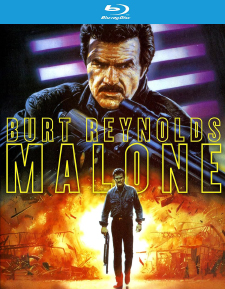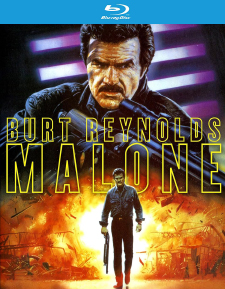Malone (Blu-ray Review)

Director
Harley CokelissRelease Date(s)
1987 (August 29, 2023)Studio(s)
Orion Pictures/MGM (Kino Lorber Studio Classics)- Film/Program Grade: B
- Video Grade: A
- Audio Grade: A
- Extras Grade: B
Review
It’s a familiar premise: a man turns his back on his past and looks to turn a new page. Westerns, gangster films, and action pictures have employed this theme with varying degrees of success for decades. In Malone, Burt Reynolds stars as a man of mystery whose chance stop in a small town has unforeseen repercussions.
Richard Malone (Reynolds) is driving along a rural road when car trouble forces him to stop in the nearest town and find a mechanic. Service station owner Paul Barlow (Scott Wilson, In Cold Blood) tells him that the transmission is shot and it will take a few days to get the parts and repair the car. The two men strike up a friendly conversation. Since there’s no sort of hotel in town, Barlow invites Malone to stay in a spare room at his house. Barlow’s 17-year-old daughter, Jo (Cynthia Gibb, Fame), is intrigued by the tall, dark stranger.
Millionaire Charles Delaney (Cliff Robertson, Charlie) has been applying strong arm tactics to get the landowners in town to sell. A right-wing demagogue, Delaney has conservative politicians taken in by his patriotic talk. With his money, armed goons, and a storehouse of weapons, he hopes to make the town the center of his operation to overthrow the government. Barlow is one of the few who have refused to sell, and that sets him and Jo up as Delaney’s targets. Malone reluctantly gets drawn into a David vs. Goliath battle to defend his hosts and thwart Delaney’s sinister plans.
Playing a man of action and few words, Reynolds has little dialogue. His acting choices range from a stone-cold stare to a low-key nonchalance that might be construed as detachment. Malone doesn’t want trouble, but he won’t back off if it comes his way. It’s also apparent that the skills he exhibits suggests a less-than-mundane background. He reacts to violence instantaneously and with skillful force, knows how to handle a gun, and is adept at out-thinking his adversaries. Reynolds, who showed his ability to be funny in many screen roles, plays it straight here and is an apt forerunner of Liam Neeson in the Taken movies.
Robertson plays power-obsessed Delaney, not as a maniacal crazy, but as a soft-spoken gentleman with a hint of menace in his eyes. He’s a wealthy businessman comfortable hosting a group of Washington politicians, but equally at home ordering his men to obliterate whomever stands in his way.
Gibb, in a role that suggests the Brandon De Wilde character Joey in Shane, is intrigued by Malone, looks up to him as a principled man of few words, and becomes concerned for his safety when he’s staying at her house. With her girlish smile and look of admiration, Gibb makes clear that Jo has a crush on the older man but respects boundaries. She’s an observer of the confrontations between Malone and Delaney’s henchmen, but later takes on a more significant role in protecting him. Kenneth McMillan as a corrupt sheriff and Lauren Hutton as a former colleague of Malone’s round out the cast.
Director Harley Cokeliss has crafted an exciting action drama. The film moves along briskly and is punctuated periodically with well staged action sequences. Fist fights, gun duels, car chases, and explosions keep things jumping, with Reynolds’ cool demeanor the steadying factor amid tumultuous chaos.
Malone was shot by director of photography Gerald Hirschfeld with Arriflex 35BL III cameras and spherical lenses on 35 mm film, and presented in the widescreen aspect ratio of 1.85:1. The transfer, sourced from an older master provided by MGM, retains the fine film grain of the original. It’s clean with no perceptible visual imperfections. Detail is nicely delineated, especially in Reynolds’ curly hair, furnishings in Barlow’s house, a bridge shown frequently, and the dusty, run-down Barlow garage. The color palette varies from earth tones in outdoor scenes to some bolder primary hues in Jo’s dresses, deep-green tree-covered mountains, and bold reds of splattered blood. Slow motion is used in one scene to dramatize a key moment.
The soundtrack is English 2.0 DTS-HD Master Audio. Optional English subtitles are available. Dialogue is uniformly clear and distinct. Reynolds has little dialogue, in keeping with the type of character he plays. The film is largely driven by visuals, often requiring considerable stunt work. Sound effects include gunfire, cars skidding, an explosion, fists pummeling bodies, and one loud scream.
Bonus materials on the Region A Blu-ray release from Kino Lorber include the following:
- Audio Commentary by Steve Mitchell and Nathaniel Thompson
- Trailer (2:10)
- Fuzz Trailer (2:59)
- Hustle Trailer (3:14)
- Gator Trailer (1:09)
- Stick Trailer (1:21)
- Heat Trailer (2:34)
- Rent-a-Cop Trailer (2:16)
Audio Commentary – The commentators note that Malone was shot in Vancouver, standing in for Oregon. They discuss the plot similarities between Malone and Shane. In both films, a stranger stops by, befriends a family, and goes up against local bad guys. Scott Wilson had a career playing character parts, able to mold himself to the role. Burt Reynolds had great respect for good actors. He knew Spencer Tracy, who advised that he not “act,” but be natural, a bit of advice Reynolds tried to follow in his movie roles. Reynolds had starred in many TV series, namely Riverboat, Gunsmoke, Hawk, and Dan August. His greatest success came with film comedies. At one point, he was one of Hollywood’s biggest stars. Malone was made during a comeback after a bad accident. Reynolds did many of his own stunts. Malone has a prescient quality in terms of the group of men headed by Delaney in a criminal conspiracy to mold the America they want to live in. Today, there are militia groups in the country that long for their own vision of the nation. Cliff Robertson doesn’t play a clichéd villain; he’s the type who has a grand vision and is patient about achieving it, no matter the cost. The frequent use of cigarettes is mentioned as an indication of the time period when many people smoked. The smoke looked great in black & white films and actors liked using cigarettes as props, giving them some physical “business” to accompany their dialogue. The commentators talk about Reynolds’ toupee and the different styles he toyed with during the 1980s. The chemistry between Lauren Hutton and Reynolds is a result of their knowing each other and having worked together previously. David Newman, who comes from a long line of musicians, wrote his fourth score for Malone. Stuntmen learn how to mimic the actor’s physicality. Tension heightens when viewers feel that a degree of real danger is involved.
Not every film is a classic and Malone never aspires to that high bar, but is nonetheless an entertaining picture. Reynolds plays an enigmatic character unafraid to confront injustice, even when outnumbered. The plot offers few surprises but the journey is enjoyable. Made in 1987, Malone has a disturbing contemporary relevance regarding those who, under the guise of patriotism, threaten basic democratic principles.
- Dennis Seuling

